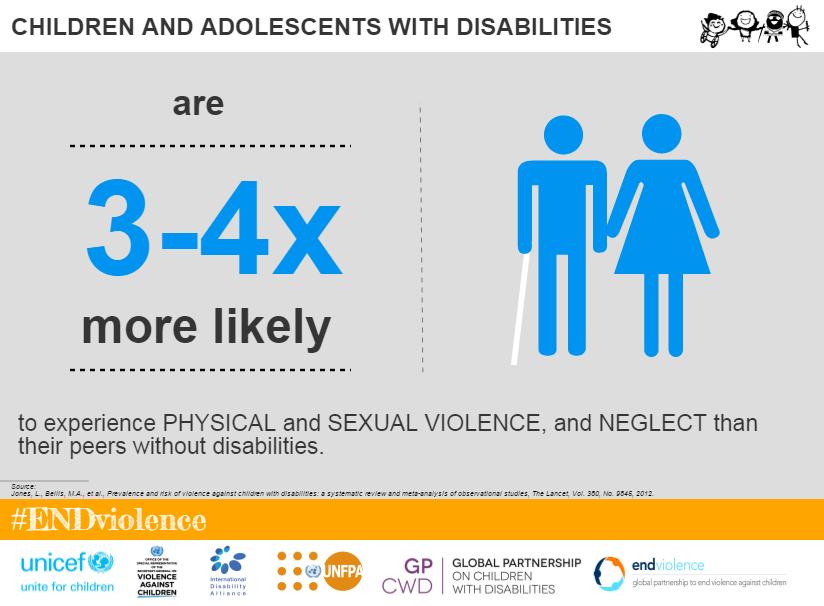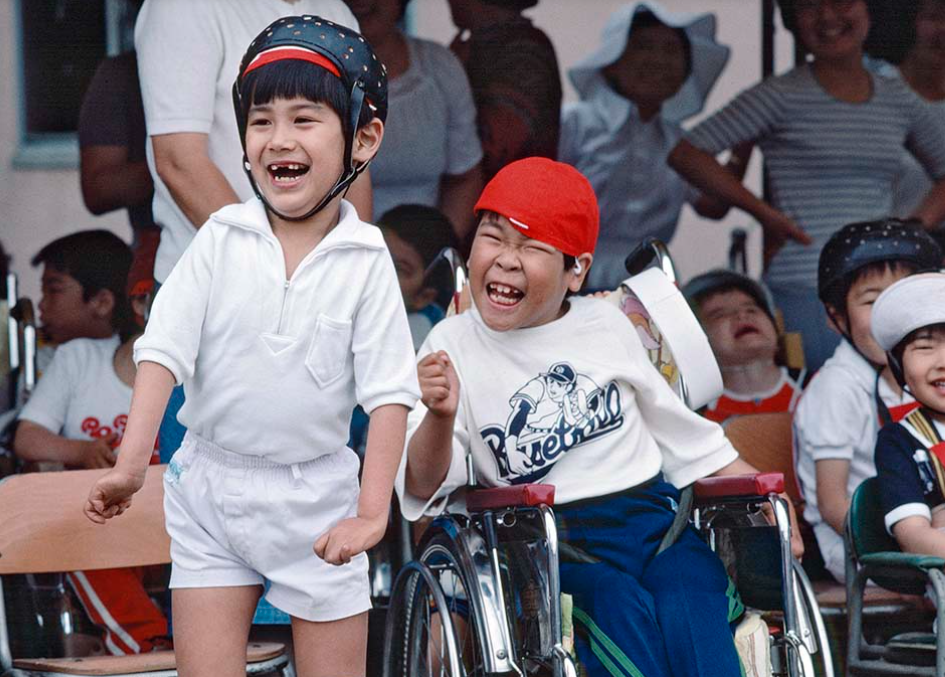Children with Disabilities

Fifteen per cent of the world’s population – at least one billion people – have some form of disability, whether present at birth or acquired later in life. Nearly 240 million of them are children.
The Convention on the Rights of Persons with Disabilities defines living with a disability as having a long-term physical, mental, intellectual or sensory impairment that – in interaction with the environment – hinders one’s participation in society on an equal basis with others.
Children and adolescents with disabilities are a highly diverse group with wide-ranging life experiences. They live in every community, and are born with or acquire distinct impairments that, in relation to their surroundings, lead to functional difficulties – like seeing, walking, communicating, caring for oneself or making friends.
Many are considered to be a cause of shame to their families and a curse and misfortune for their communities. The lives of children with disabilities can be surrounded by stigma, discrimination, cultural prejudices, ill-perceptions and shocking invisibility. In addition, children with disabilities are at dramatically heightened risk of violence, neglect, abuse and exploitation.
In spite of limited data and research, available studies reveal an alarming prevalence of violence against children with disabilities – from higher vulnerability to physical and emotional violence when they are young to greater risks of sexual violence as they reach puberty.
Indeed, children and adolescents with disabilities are 3 to 4 times more likely to experience physical and sexual violence and neglect than other children; and they are at significantly increased risk of experiencing sexual violence: up to 68% of girls and 30% of boys with intellectual or developmental disabilities will be sexually abused before reaching their 18th birthday.
The Sustainable Development Agenda includes for the first time a specific target (16.2) to end all forms of violence against all children. The SDGs provide a shared sense of purpose and a renewed impetus to worldwide efforts while leaving no child behind. This is also an obligation States have undertaken by ratifying international human rights treaties.
The Convention on the Rights of the Child recognizes that all children, including children with disabilities, are entitled to protection from all forms of violence. States are required to take all appropriate measures to ensure the protection of the rights of children without discrimination of any kind.
The Convention on the Rights of Persons with Disabilities affirms that all persons with disabilities, including children, should enjoy all human rights and fundamental freedoms and should be protected from "all forms of exploitation, violence and abuse, including their gender-based aspects". Girls with disabilities, in particular, "are often at greater risk, both within and outside the home, of violence, injury or abuse, neglect or negligent treatment, maltreatment or exploitation".
Children with disabilities, out of fear or as a result of lack of information, may feel pressed to conceal their suffering, afraid of stigmatization, harassment or reprisals and might not be able to make a complaint or report the incident of violence they suffer, and they may believe they could lose the support of their caregivers and the attention and love of the individuals they depend on.
Incidents of violence reported by children with disabilities are largely dismissed as their caregivers are often unprepared and ill-trained to consider the complaints and to effectively take them into account. There is a prevailing perception that children with disabilities are not able to tell their stories clearly and are easily confused.
In many countries, legislation does not recognize the testimony of children with disabilities and the law does not allow them to sign their names in legal documents or to give evidence under oath. There is a conspiracy of silence and widespread impunity surrounding these incidents of violence.
It is urgent to adopt in all countries legislation banning all forms of violence against all children and to establish effective and well-resourced child and disability sensitive mechanisms to prevent and address incidents of violence.
It is essential to invest in awareness raising and information, including research about child disability and the forms and prevalence of violence compromising the enjoyment of their rights. This can be best done if we work together with children with disabilities and their families, and organizations promoting their rights.
United Nations Disabilities Strategy
 The United Nations Disability Inclusion Strategy provides the foundation for sustainable and transformative progress on disability inclusion through all pillars of the work of the United Nations: peace and security, human rights, and development.
The United Nations Disability Inclusion Strategy provides the foundation for sustainable and transformative progress on disability inclusion through all pillars of the work of the United Nations: peace and security, human rights, and development.
The Strategy enables the UN system to support the implementation of the Convention on the Rights of Persons with Disabilities and other international human rights instruments, as well as the achievement of the Sustainable Development Goals, the Agenda for Humanity and the Sendai Framework for Disaster Risk Reduction. The Strategy includes a policy and an accountability framework, with benchmarks to assess progress and accelerate change on disability inclusion. The policy establishes a vision and commitment for the United Nations system on the inclusion of persons with disabilities.
PHOTO | Children with disabilities during a sport event | UN Photo.
___________________________________________________
The strategy is based on three over-arching approaches to achieve disability inclusion:
TWIN-TRACK APPROACH
Disability is a cross-cutting issue and should be considered in all our work – this is the first track. Targeted programming is also required – this is the second track.
INTERSECTIONALITY
Factors such as gender, age and location inform an individual’s experience. These factors also impact people with disabilities and their life experiences.
COORDINATION
A coherent and coordinated approach is essential to accelerate progress, build on each other’s work and achieve inclusion.
Contact UN disabilities section: disabilitystrategy@un.org

